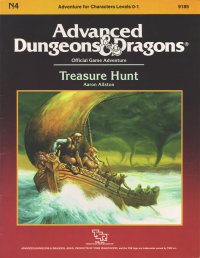
Dungeonland (EX1) is a 1983 adventure module for the Dungeons & Dragons (D&D) roleplaying game, written by Gary Gygax for use with the First Edition Advanced Dungeons & Dragons (AD&D) rules. It is an adaptation of Lewis Carroll's 1865 novel Alice's Adventures in Wonderland, with the various characters from the book translated into AD&D terms.

Ravenloft is an adventure module for the Dungeons & Dragons (D&D) fantasy role-playing game. The American game publishing company TSR, Inc. released it as a standalone adventure booklet in 1983 for use with the first edition Advanced Dungeons & Dragons game. It was written by Tracy and Laura Hickman, and includes art by Clyde Caldwell with maps by David Sutherland III. The plot of Ravenloft focuses on the villain Strahd von Zarovich, a vampire who pines for his lost love. Various story elements, including Strahd's motivation and the locations of magical weapons, are randomly determined by drawing cards. The player characters attempt to defeat Strahd and, if successful, the adventure ends.

Day of Al'Akbar is an Advanced Dungeons & Dragons adventure module written by Allen Hammack and published by TSR inc. in 1986. The module consists of a forty-page booklet with a large color map and an outer folder. It bears the Dungeons & Dragons code I9, I meaning intermediate and 9 for module 9 in that series.

In Search of the Unknown is a module for the Dungeons & Dragons roleplaying game, designed for use with the Basic Set of rules. It was written by game designer Mike Carr and was first published in 1978 by TSR, Inc. The module details a hidden complex known as the Caverns of Quasqueton. Reviewers considered it a good quality introduction to the game that was written in the so-called dungeon crawl style, where the primary goal of the players is the exploration of a dangerous labyrinth to battle monsters and obtain treasure.

Scourge of the Slave Lords (A1–4) is an adventure module for the Dungeons & Dragons fantasy role-playing game, published by TSR, Inc. in 1986. It combines the contents of four earlier modules, all set in the World of Greyhawk campaign setting and intended for use with Advanced Dungeons & Dragons first edition rules.
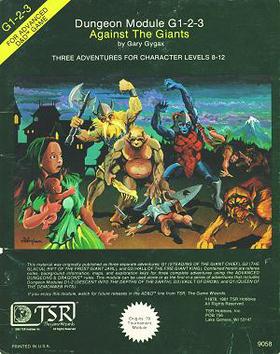
Against the Giants is an adventure module written by Gary Gygax and published by TSR in 1981 for the Dungeons & Dragons fantasy role-playing game. It combines the G series of modules previously published in 1978: Steading of the Hill Giant Chief, Glacial Rift of the Frost Giant Jarl, and Hall of the Fire Giant King. All three were produced for use with the 1st edition Advanced Dungeons & Dragons rules. In 1999, to recognize the 25th anniversary of TSR, the company released an updated version, Against the Giants: The Liberation of Geoff. Later in 1999, Wizards of the Coast published a novelization of Against the Giants by Ru Emerson.
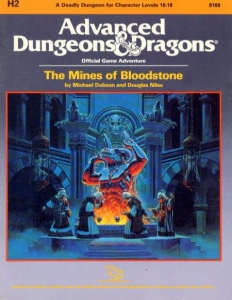
H2 The Mines of Bloodstone is an official game adventure or "module" for the Advanced Dungeons & Dragons fantasy role-playing game.

The Gem and the Staff, by John and Laurie Van De Graaf, is an adventure module for the Dungeons & DragonsExpert Set. Rather than being a typical group adventure, The Gem and the Staff was designed for head-to-head tournament-style play, with players separately playing the same adventure and competing against each other for points earned by accomplishing certain goals. The adventure is only playable with one dungeon master (DM) and one player.
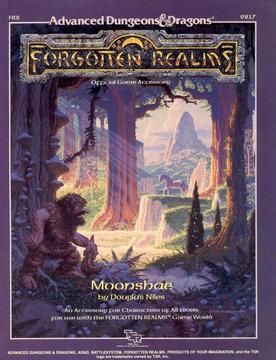
Moonshae is an accessory for the Dungeons & DragonsForgotten Realms campaign setting. It describes the Moonshae Isles of Faerûn.
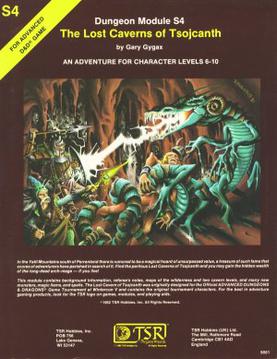
The Lost Caverns of Tsojcanth is an adventure module for the Dungeons & Dragons fantasy role-playing game. It was written by Gary Gygax and published by TSR in 1982 for the first edition Advanced Dungeons & Dragons (AD&D) rules. The 64-page adventure bears the code "S4" and is set in the Greyhawk campaign setting. It is divided into two parts, a 32-page adventure, and a 32-page booklet of monsters and magic items. The plot involves the player characters investigating rumors of lost treasure. After traversing a wilderness and two levels of dungeons, the players face Drelnza, the vampiric daughter of long-deceased archmage Iggwilv.
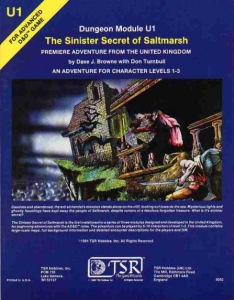
The Sinister Secret of Saltmarsh is a module for the Advanced Dungeons & Dragons (AD&D) roleplaying game, written by Dave J. Browne with Don Turnbull. The module details a mysterious abandoned mansion at the edge of a town called Saltmarsh, and the secrets contained therein. The adventure is set in the World of Greyhawk campaign setting. The Sinister Secret of Saltmarsh received positive reviews from critics.
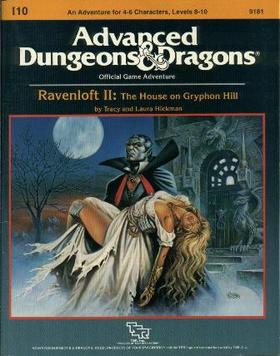
Ravenloft II: The House on Gryphon Hill is a Dungeons & Dragons module written for use with the First Edition Advanced Dungeons & Dragons ruleset, by TSR.
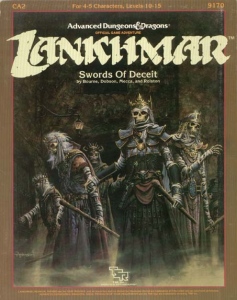
Swords of Deceit is a 1986 adventure module for the Advanced Dungeons & Dragons fantasy role-playing game, for the Lankhmar setting.
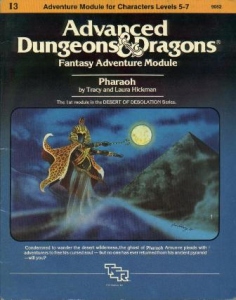
Desert of Desolation is a compilation adventure module published by TSR for the Dungeons & Dragons (D&D) fantasy roleplaying game. It combines three previously published individual modules: Pharaoh, Oasis of the White Palm, and Lost Tomb of Martek. The modules were made for use with the first edition Advanced Dungeons & Dragons (AD&D) rules. Pharaoh was created by Tracy and Laura Hickman soon after the couple married in 1977, and published by TSR in 1982. Oasis of the White Palm was a collaboration between Tracy Hickman and Philip Meyers, and Hickman wrote the Lost Tomb of Martek on his own; both were printed in 1983.

The Veiled Society is an adventure module for the Basic Rules of the Dungeons & Dragons fantasy role-playing game published in 1984. The adventure's product designation is TSR 9086.

Night's Dark Terror is an adventure module for the Dungeons & Dragons (D&D) fantasy role-playing game written by British game designers Jim Bambra, Graeme Morris, and Phil Gallagher. It was designed specifically for campaigns transitioning from the D&D Basic Set to the D&D Expert Set. The player characters (PCs) journey from a farmstead into uncharted wilderness, where they encounter new hazards and contend with a secret society. The adventure received a positive review from White Dwarf magazine.
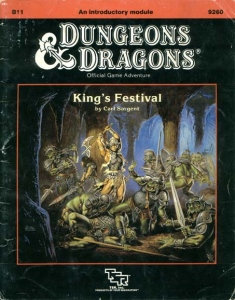
King's Festival is an adventure module for the Dungeons & Dragons fantasy role-playing game.

Lankhmar – City of Adventure is an accessory for the Dungeons & Dragons fantasy role-playing game, first published by TSR in 1985.

The Book of Lairs is an accessory book for the Dungeons & Dragons fantasy role-playing game, first published by TSR in 1986. It contains an assortment of monster-themed mini-adventures. A second volume was published in 1987. TSR coded the accessories REF3 and REF4 respectively, as part of a series of similarly-coded accessories. Both volumes were received well by critics, with the second being seen more positively than the first.

Legions of Thyatis is an adventure module published in 1990 for the Dungeons & Dragons fantasy role-playing game.
